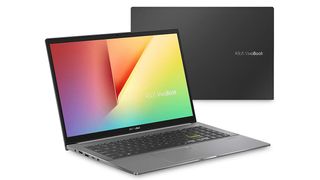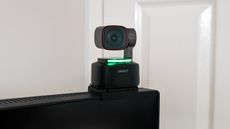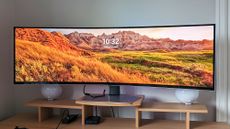If you're looking for the best laptop then you need to know both how the top models rate in terms of their specs, and how they compare against each other – and with that in mind we're going to put the Asus VivoBook S15 up against the Lenovo IdeaPad 3 right here.
These are both very good laptops that we'd be happy to recommend, but you might find that one suits you better than the other, depending on your budget and your needs. We've looked at everything from screen size to battery life to port selection to compare them.
Perhaps the most important difference between these laptops to begin with is the price – they've been discounted a whole lot as they're a couple of years old now. Check the widgets on this page for the latest deals, as there are some crackers available right now.
Asus VivoBook S15 vs Dell XPS 13: design and screen

The Asus VivoBook S15
The screen size is an important spec when it comes to laptops – not only does it have an impact on how much room you've got for your movies and your spreadsheets, it also dictates the overall size of the device (and its keyboard). If you need something that's easy to carry around and sling in a bag, then you're probably going to want to opt for a display size under 15 inches. Pay attention to the resolution too, which affects the sharpness of text and images on screen.
As is the norm for laptops, these two offer several configurations under the same name (it makes them more difficult to compare, but we'll explain it as best we can): the Asus VivoBook S15 is straightforward as far as the display goes, because it's only available with a 15.6-inch, FHD (1920 x 1080 pixel), 16:9 screen. In our review, we found it bright, vivid and sharp, and impressive for any task.
When it comes to the Lenovo IdeaPad 3, you can actually get that laptop with four different 16:9 aspect ratio displays – the models are 14-inch FHD (1920 x 1080 pixels), 14-inch HD (1366 x 768 pixels), 15.6-inch FHD (1920 x 1080 pixels) and 15.6-inch HD (1366 x 768 pixels). The bigger and sharper you want your display, the more you'll have to pay, though the price difference isn't massive.

The Lenovo IdeaPad 3
In terms of brightness and sharpness and aspect ratio, there's little to choose between the Asus VivoBook S15 and the Lenovo IdeaPad 3, but if you want a smaller 14-inch screen for the increased portability then you're going to have to go with Lenovo. Both the Asus and the Lenovo laptops make use of the extra space on the 15.6-inch models to add a full number pad to the keyboard (you don't get this on the 14-inch Lenovo).
In terms of design, this is where personal preference comes in. We think both laptops have a tasteful, streamlined aesthetic, though the VivoBook S15 does have a more premium feel to it (the highlighted Enter key helps). The 15.6-inch VivoBook S15 weighs in at 1.8 kg or 3.97 lbs, compared with 1.85 kg or 4.08 lbs for the 15.6-inch IdeaPad 3; the 14-inch IdeaPad 3 tips the scales at 1.6 kg or 3.53 lbs.
The Lenovo laptop comes in Platinum Grey, Abyss Blue or Cherry Red, while your choices for the Asus VivoBook S15 are Gaia Green, Resolute Red, Indie Black or Dreamy White. The Asus offers more port choices: 3 x USB-A, 1 x USB-C, 1 x HDMI 1.4, 2 x card readers and 1 x 3.5 mm audio jack compared with 3 x USB-A, 1 x HDMI 1.4, 1 x card reader and 1 x 3.5 mm audio jack on the Lenovo models.
Asus VivoBook S15 vs Lenovo IdeaPad 3: specs and performance

The Asus VivoBook S15
It's really in the specs and the performance where the extra expense of the Asus VivoBook S15 compared with the Lenovo IdeaPad 3 really comes into play. Again, there are multiple configurations to talk about: the VivoBook S15 offers a choice of two 10th-gen Intel i5 and two 10th-gen Intel i7 processors to pick from, depending on how much power you need.
That's combined with 8GB or 16GB of RAM, and a range of storage options that go all the way up to a 1TB SSD. You've got a choice when it comes to graphics as well, from integrated Intel UHD Graphics up to an Nvidia GeForce MX350 GPU with 2GB of its own video memory to draw on.
Turning to the Lenovo IdeaPad 3 models, the processor options top out at a AMD Ryzen 7 3700U, no slouch but less powerful than the Intel chips available with the Asus laptop. The maximum RAM you can get installed is 8GB, while the storage options go up to a 512GB SSD or a 256GB SSD plus a 1TB HDD if you need more space but don't need the super-speedy disk access of SSD for everything.

The Lenovo IdeaPad 3
When it comes to graphics configurations, Lenovo promises you can get discrete AMD Radeon graphics but we can only see integrated options on the market at the moment – enough for day-to-day computing tasks but not what you would want to rely on for gaming or demanding image and video editing processes. Of course, this lower spec is reflected in the lower price, which is always worth bearing in mind.
In terms of the on-board audio, the laptops seem pretty evenly matched, although the Lenovo models bring with them Dolby Atmos compatibility that the Asus models don't offer. The Asus VivoBook 15 does have support for the latest Wi-Fi 6 standard, unlike the Lenovo IdeaPad 3, but you're probably not going to notice the difference too much (especially if you don't have a Wi-Fi 6 router). Battery life on both the Asus and Lenovo laptops seems to be between the 7 and 8 hour mark, so you'll be able to take them away from the mains charger for a day.
Overall, the Asus is the more powerful of the two in just about every department, even if it's not quite up to the level of gaming laptops (which would require heavier, bigger components). The Lenovo laptop is still perfectly fine for everyday computing however, and so you might consider the lower cost to be more important if you're only going to be writing essays and sending emails with your laptop.
Asus VivoBook S15 vs Lenovo IdeaPad 3: price and verdict

The Asus VivoBook S15
Comparing two laptops isn't an exact science, because there are usually so many configurations to pick from (and they change over time too). For example, we've only been focusing on one particular variation of the Asus VivoBook S15, the S533 model, which is still available in a variety of configurations when it comes to the internal processor, the on-board graphics and so on, as we've already explained.
It's also difficult to compare performance because there are so many different factors at play, from the processor on board to the speed of the storage. If you're just browsing the web, you might not notice much of a difference at all between the Asus VivoBook S15 and the Lenovo IdeaPad 3 – but if you're working with a lot of large images or trying to run some games, the difference will be much more noticeable.
You may well prefer the look of either the Asus VivoBook S15 or the Lenovo IdeaPad 3, which could make a purchasing decision easier: they're both capable, stylish laptops running Windows 10, so it might come down to which one you like more in terms of the appearance and materials used. Bear in mind that you are going to have to be staring at it for most of the working day (we assume).

The Lenovo IdeaPad 3
Most of all though, it's a choice between price and performance. Laptop prices are adjusted and tweaked on an almost constant basis – you can see some of the latest deals on the web linked on this page – but generally speaking the Lenovo IdeaPad 3 can be picked up for around £400-£450, while you're probably going to have to pay double that to get your hands on the Asus VivoBook S15.
If you're going to make use of the extra power that the VivoBook S15 gives you, then that extra expense may well be worth it – it's also likely to last you a longer time before slowing down to the point of obsolescence, which is almost something to bear in mind when you're trying to to decide on a budget for a new piece of technology.
If your needs are more modest and you have better ways to spend your money, then the IdeaPad 3 from Lenovo will do you very well indeed: it's still more than capable of taking care of common computing tasks, it comes with some useful features, and there's also the choice of two different screen sizes to think about too.











